A solid customer relationship management (CRM) strategy is crucial for any business planning to use a CRM platform.
The two go hand in hand — using the software without the strategy is like steering a ship without a rudder. In effect, a CRM strategy determines how a business uses the CRM software, as well as its people and processes.
In this article, we’ll highlight the benefits of using a CRM strategy and show you how to create a successful one for your business that works in tandem with a robust CRM system.
What defines a successful CRM strategy?
A CRM strategy is a company-wide plan for your business to enhance customer relationships, grow revenue, and ultimately increase profit using specific actions and technology.
Many people often use the term CRM (customer relationship management) to describe the software used to manage customer relationships. However, CRM also covers the strategy, processes, and people a business uses to engage and convert potential customers while retaining current ones.

The CRM cycle involves several key stages for managing and improving customer relationships across sales, marketing, and customer service activities. These stages typically include:
- Reach: The first step involves generating brand awareness through various marketing channels like social media and paid adverts.
- Acquisition: The next stage involves reaching out to potential customers and acquiring them as leads or prospects.
- Conversion: Once leads are acquired, the focus shifts to converting them into paying customers through targeted sales and marketing efforts.
- Retention: After acquiring customers, the goal is to retain them by providing excellent customer service and maintaining ongoing communication.
- Loyalty: Building customer loyalty is the final stage of the CRM cycle, where you create long-term, loyal customer relationships.
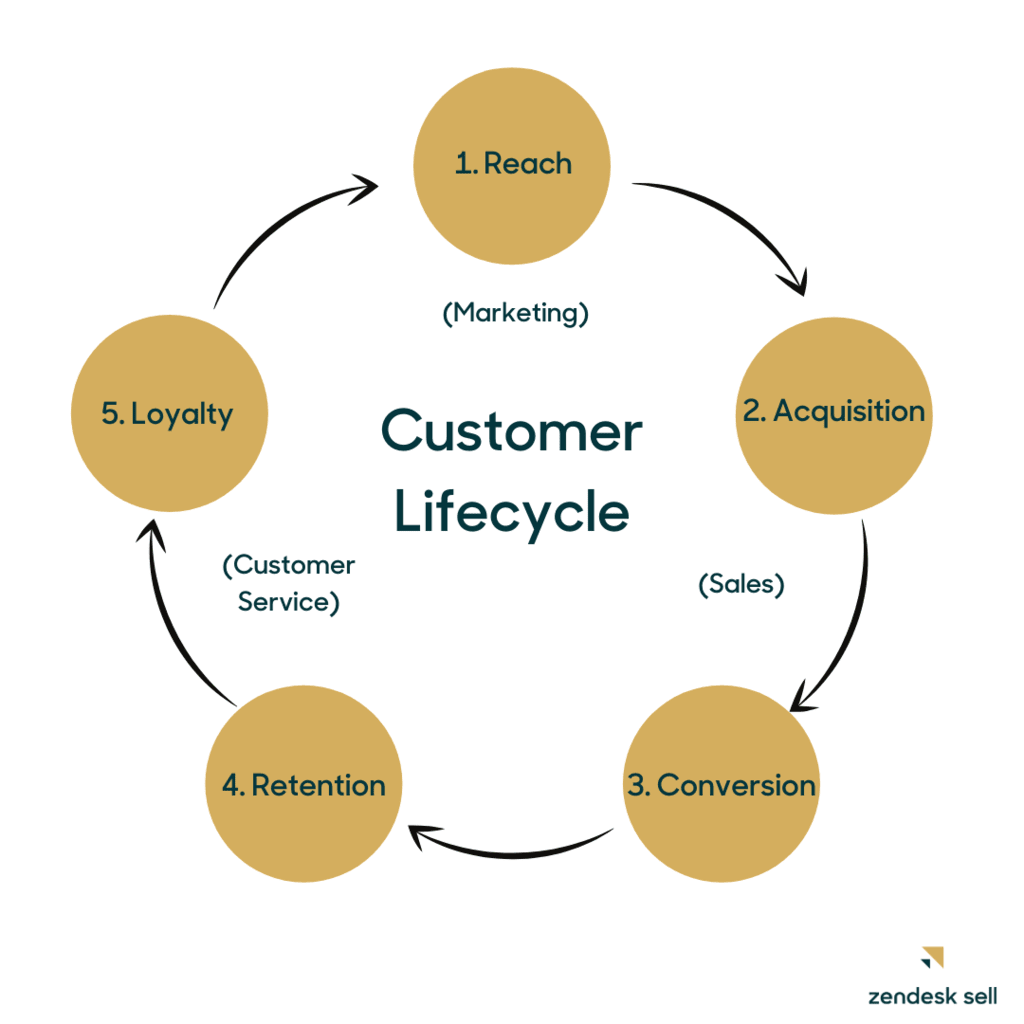
By understanding and effectively managing these stages, businesses can improve their sales, marketing, and customer service efforts to increase customer satisfaction and company revenue.
Why a CRM system is essential for your business
A CRM system enables you to manage your customers throughout their entire lifecycle so that every team can access the same information.
While implementing a CRM system before creating a CRM strategy is unnecessary, they are interconnected. For example, with a CRM system, you get access to features like:
- Contact management: Get a 360-degree view of your customers with up-to-date contact and account information records. Log activities, send emails, and access all past interactions, deals, and projects associated with an account or contact in one visual format.
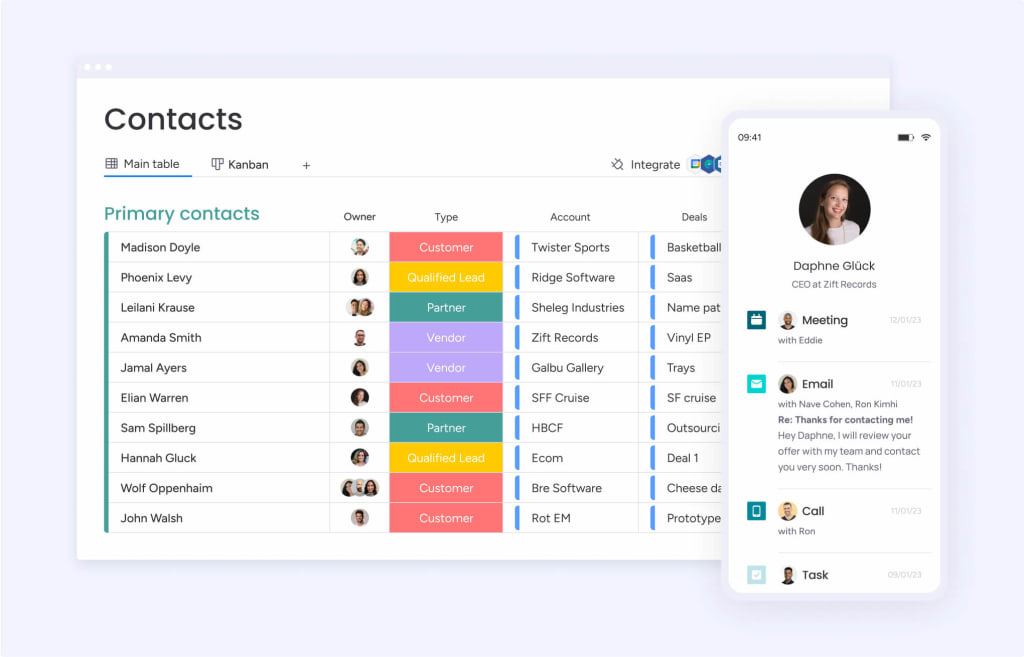
- Lead management: Collect and qualify leads from various sources in one central location and use email templates for fast automated email follow-ups.
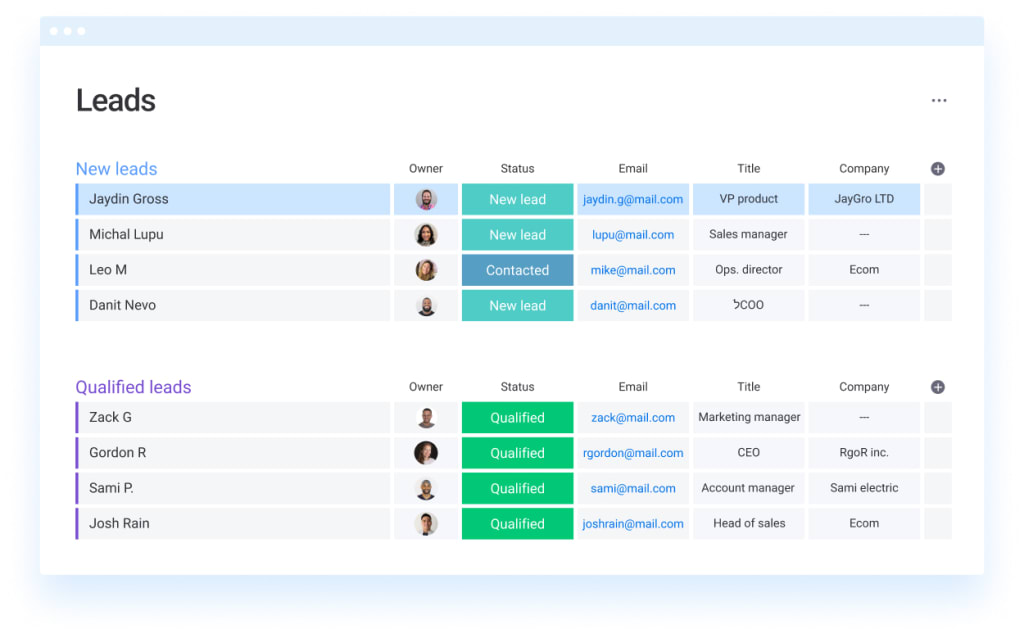
- Deal management: Check where deals stand with a customized visual pipeline and track all contact interactions in one place.
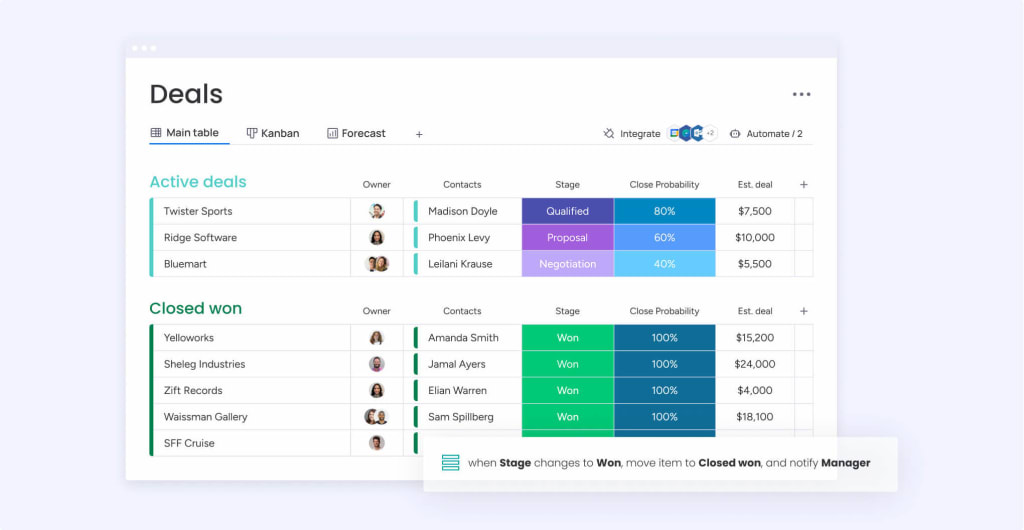
- Sales forecasting: Keep track of your sales projections and report on forecast vs. actual sales. Drill down forecast by month, sales rep, or any other criteria.
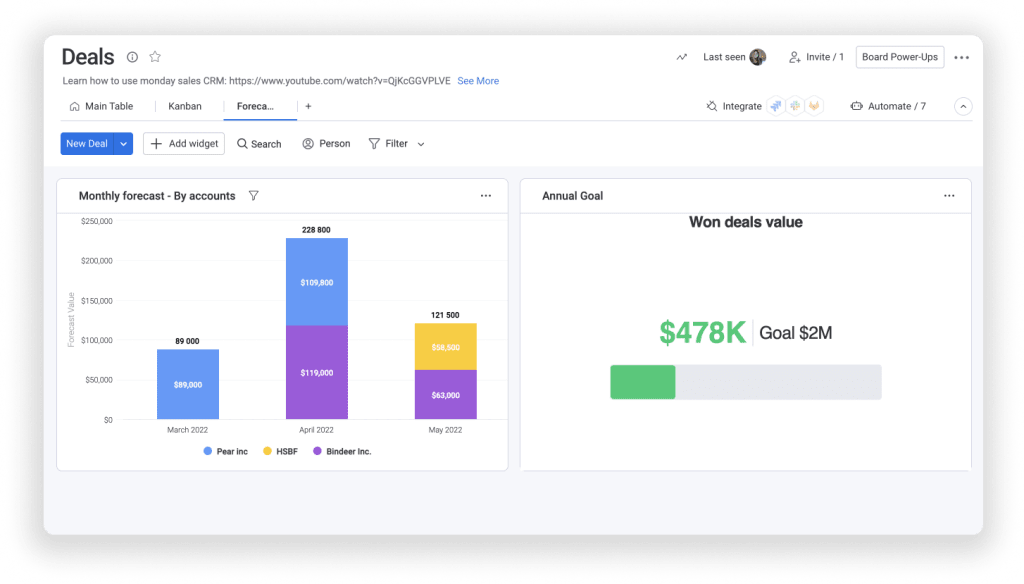
- Performance tracking: Manage your team’s quotas over time and make data-driven decisions with real-time tracking and reports. Gain insights with fully customizable pre-built dashboards.
![]()
- Account management: Track the onboarding progress of your clients and manage renewals.
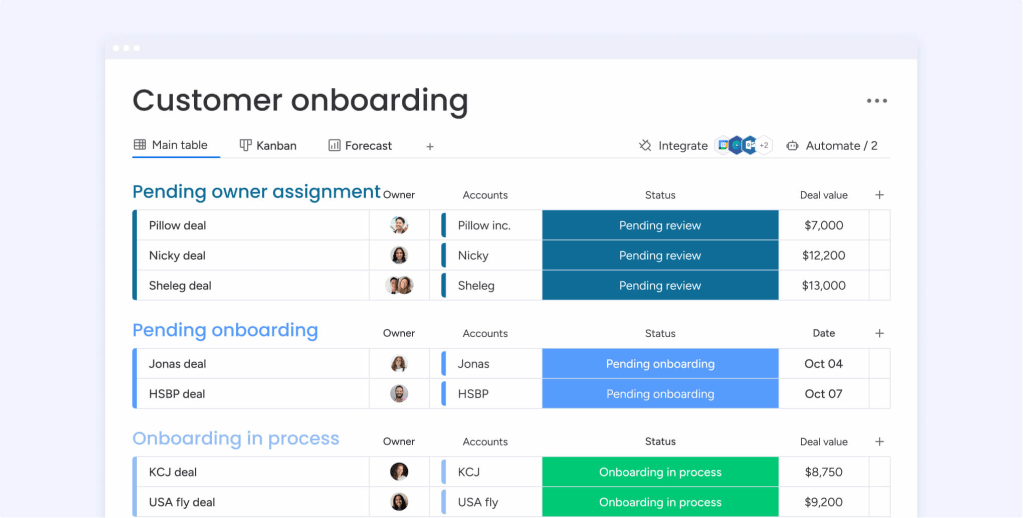
You get all of these features, and more, in monday sales CRM.
Try monday sales CRMWhat are the benefits of creating a CRM strategy?
A successful CRM strategy will help your business:
- Strengthen collaboration between sales, marketing, and customer service teams.
- Deliver a satisfying customer experience every time.
- Keep track of your leads, prospects, and customers throughout the pipeline.
- Identify the best opportunities for sales teams to target and bring in more revenue.
- Create more targeted and personalized marketing campaigns.
- Gain valuable insights to improve future performance.
What you need before building your CRM strategy
Before building your CRM strategy, there are several steps and considerations to keep in mind. Here are the essential elements you need to address:
- Audit your business: Conduct a SWOT analysis to identify your company’s current strengths, weaknesses, opportunities, and threats.
- Refine your vision: Develop a clear vision that your teams can collaborate on and execute, such as increasing revenue, improving customer relationships, and enhancing the overall customer experience.
- Audit your customer data: Understand your target customers and their typical journey — such as demographics, touchpoints, and product feedback — and identify areas for improvement in your interactions with them.
- Integrate your systems and data: Ensure all teams can work seamlessly with the same customer information in one centralized system.
How to create your CRM strategy in 10 steps
Now that you know what defines a successful CRM strategy and how it can benefit your business, let’s walk you through how to create one for your organization.
Step 1: Define your CRM strategy goals
First, you need to determine what you want to achieve with your customer relationship management plan. For example, perhaps you want to shorten your sales cycle, increase your customer satisfaction survey scores, or reduce churn. Ensure your CRM strategy goals align with your overall business goals and objectives, and make them SMART:
- Specific
- Measurable
- Achievable
- Relevant
- Time-bound
Once you’ve defined your goals, evaluate whether or not you can realistically achieve those goals with your current resources. For example, do you have enough team members and the right tools, like a CRM system, to accomplish your goals?
Setting your CRM strategy goals keeps you focused on your business and its bottom line.
Step 2: Define your target customer (with buyer personas)
It’s essential to understand who your customers and prospects are so that you can create buyer personas. Understanding exactly who is purchasing from you and why, will help you attract quality leads with the right tactics and messaging and maintain strong customer relationships.
You can combine your existing data with new research to build your ideal customer profile. For example, you could:
- Use website analytics to gather demographic data about visitors.
- Discover their preferred social media networks.
- Interview your sales and customer service teams.
- Interview customers directly or send customer surveys.
- Hold a focus group with customers/clients.
Use our buyer persona template to help you better understand your customers and target market based on demographics, geography, needs, interests, and behavior.
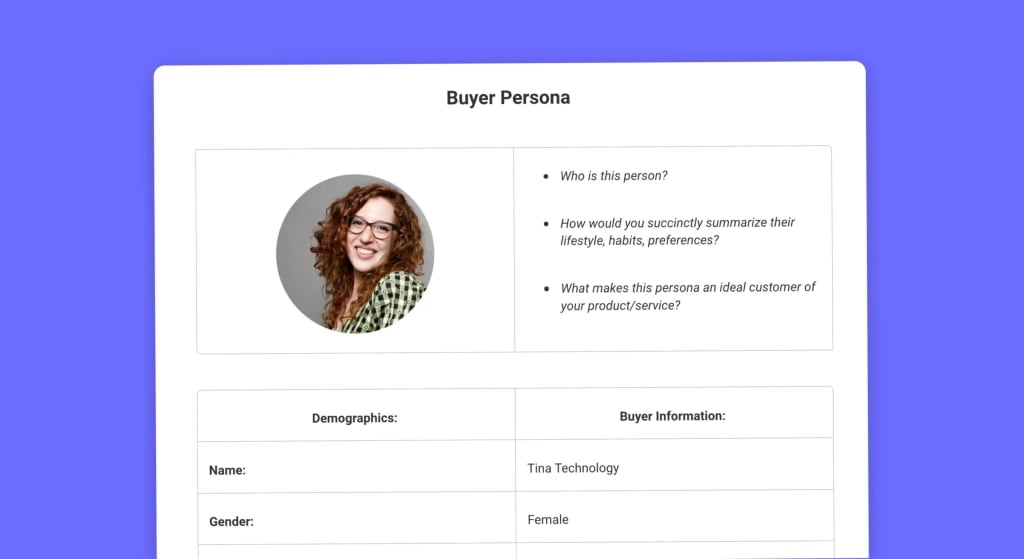
Step 3: Outline your customer journey
Once you’ve defined your target customer, you need to map out their entire journey from the first touchpoints to the closing sale. Analyze their demographic data to find out where they spend their time online. Understanding their online habits can help you identify where and how to connect with them.
Here are some key questions to ask when mapping the customer journey:
- Which team is interacting with the customer at each stage?
- How can these interactions be improved?
- Is this your target customer’s preferred style of communication?
- Which content does your customer interact with the most or the least?
- What is the customer trying to achieve?
- What challenges does the customer face?
From these answers, double-check that the customer journey relates to your buyer personas.
Step 4: Plan your 360-degree customer experience
The next step in your strategy is ensuring you have the resources and processes to provide a 360-degree customer experience. Check each team’s roles and responsibilities. For example:
- Can your marketing team analyze customer needs and gather information effectively?
- Can your sales team automate any sales processes to increase speed and efficiency?
- Can your customer service team onboard and support customers effectively?
Remember to make your communications relevant and engaging to your customers throughout their lifecycle.
Step 5: Define your KPIs
Having defined your CRM strategy goals in Step 1, you need to give your teams some concrete targets to work towards. Some metrics you may wish to measure include:
- Sales cycle length
- Sales close rate
- Customer satisfaction
- Customer retention
- Customer churn
- Profitability per customer/account
For example, using a SMART goal, you might ask your customer service team to increase customer satisfaction rates by 3% in Q2. Or, if a CRM strategy goal for the after-sales team is to increase customer retention, an important KPI might be to increase the number of renewal opportunities in the pipeline year-to-date (YTD) compared with the same period last year.
Step 6: Leverage data to improve productivity
A CRM platform lets you consolidate customer data from different departments, such as marketing, sales, and customer service, in a single dashboard. Teams can leverage this data quickly and efficiently to improve their productivity. For example, a single source of truth can prevent sales teams from wasting time asking customers the same questions or handling data twice.
Outline processes in your CRM strategy that facilitate this, including employee education, keeping data error-free, and integrating disparate data.
Step 7: Refine your tone and messaging
Because your CRM strategy applies to the entire customer lifecycle, you must ensure all staff use the same tone and messaging in all your customer-facing content. For example:
- Does your company use a serious, humorous, sarcastic, or optimistic tone of voice?
- Do you use light-hearted abbreviations like “lol” or follow strict grammar rules?
Consider creating brand and style guidelines, so everyone consistently uses the same tone and messaging.
Step 8: Deliver personalized customer experiences
A solid CRM strategy ensures that all your business processes, from marketing and sales to IT, work together systematically. This helps you better understand who your potential customer is and what they need.
There’s a whole raft of statistics to show that customers prefer a personalized experience. For example:
- 80% of consumers are more likely to buy from a company that provides a tailored experience.
- 63% of consumers won’t buy from brands that have poor personalization.
- 42% of customers are frustrated by impersonalized content.
Personalization improves the customer experience and, ultimately, drives revenue and customer loyalty.
Step 9: Reduce costs with automation
With a CRM system, you can save time and money by automating repetitive administrative tasks, such as feeding lead data into your sales pipeline. For example, instead of manually typing in data, you can set up your lead capture forms to automatically sync with your pipeline.
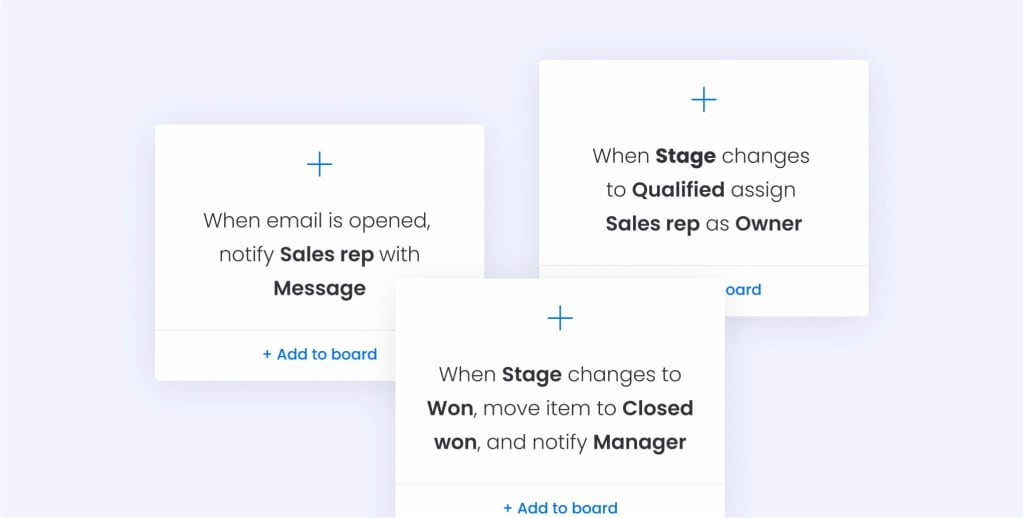
Another benefit of automation is that you can set up email templates correctly formatted with your tone of voice and personalized with the correct contact name to save time and boost sales. Automating your sales processes will free up additional time for your sales reps. They can invest this time nurturing leads and closing more deals, shortening the sales cycle and reducing your costs.
Step 10: Track your CRM performance
Finally, you want to ensure you track your team’s performance to ensure they’re achieving their individual targets and meeting your CRM strategy goals. You can easily track performance with the help of CRM reporting and analytics features that come built-in with most CRM platforms.
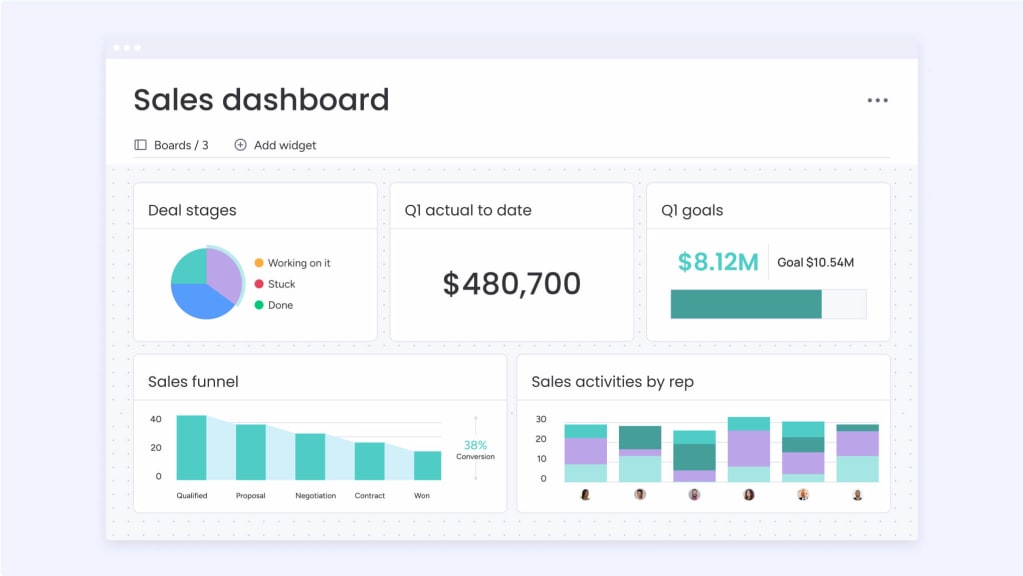
Use CRM dashboards to analyze what went well and what didn’t, identify opportunities for improvement, and experiment with new techniques. This will help you learn from mistakes, optimize processes, improve customer experiences, and refine your CRM strategy.
Bonus Step: Make use of AI
AI is now standard in most CRM platforms, so you should consider how to incorporate its features in your CRM strategy. For example, you could use AI in sales to:
- Turn ideas or meeting outcomes into actionable tasks to move deals forward automatically.
- Create different types of emails that hit just the right note every time.
- Craft polished content for every step of the customer lifecycle.
- Summarize call transcripts and meeting notes.
- Build formulas for the most complex pipeline reporting needs using your own words.
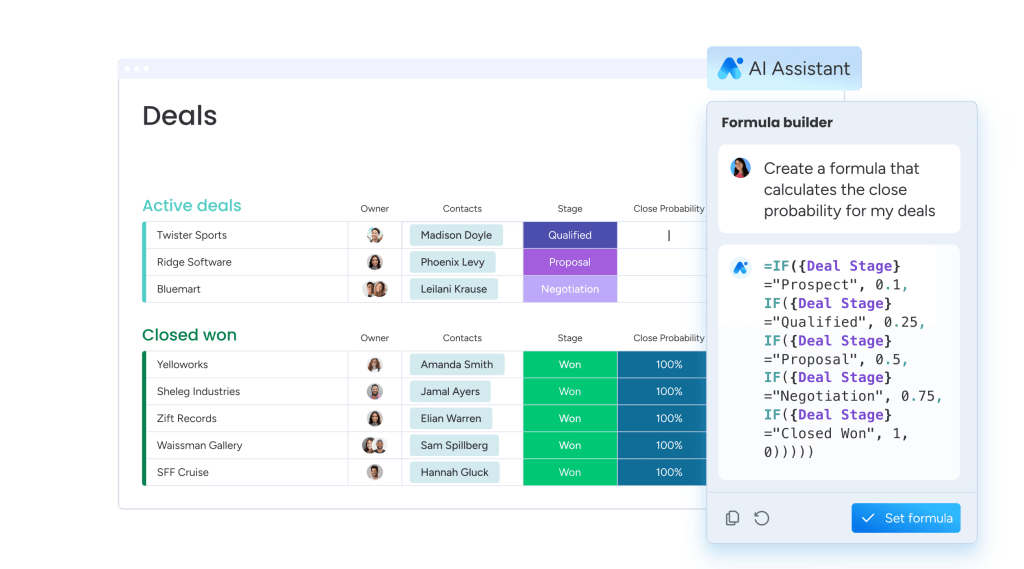
This can really take your strategy, and in turn your business, to the next level.
Read also: Generate emails with monday AI email generator
Try monday sales CRMManage your CRM strategy with monday.com
Although you might be feeling overwhelmed with all these steps, keep in mind that developing a CRM strategy will benefit your business enormously. Whether you’re planning to implement a CRM in your small business or large enterprise, creating a CRM strategy to understand why you’re using it and how it aligns with your overall business strategy, sales goals, and company culture is critical.
And, if you’re looking for a visual, intuitive, and fully customizable CRM platform to manage your leads, prospects, and customers, then monday sales CRM can help you manage your pipeline, automate your sales processes, streamline communication, and gain valuable insights into your entire CRM cycle.
Try monday sales CRM yourself with a 14-day free trial.

